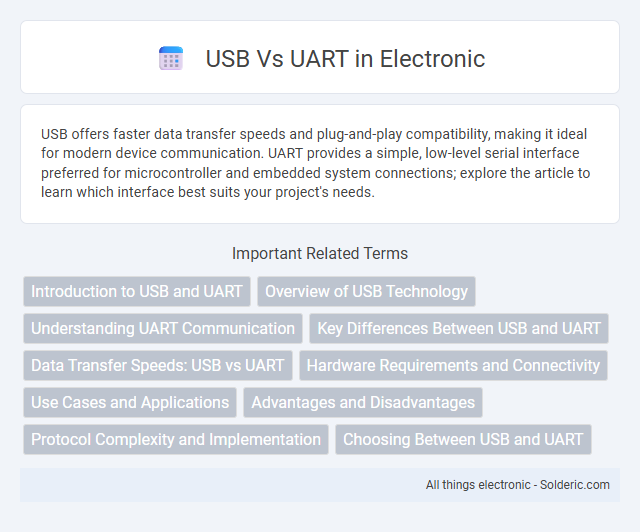USB offers faster data transfer speeds and plug-and-play compatibility, making it ideal for modern device communication. UART provides a simple, low-level serial interface preferred for microcontroller and embedded system connections; explore the article to learn which interface best suits your project's needs.
Comparison Table
| Feature | USB (Universal Serial Bus) | UART (Universal Asynchronous Receiver/Transmitter) |
|---|---|---|
| Type | Serial communication interface | Asynchronous serial communication protocol |
| Data Transfer Speed | Up to 10 Gbps (USB 3.1) | Typically up to 1 Mbps |
| Communication Mode | Half-duplex or full-duplex (depends on implementation) | Full-duplex |
| Connection Type | Multi-device bus topology | Point-to-point connection |
| Signal Type | Differential signaling (D+ and D- lines) | Single-ended signaling (TX and RX lines) |
| Power Supply | Provides 5V power up to 900 mA (USB 3.0 and above) | No power delivery capability |
| Use Cases | Peripheral connection, data transfer, charging | Embedded systems, microcontroller communication |
| Hardware Complexity | Higher complexity (requires host controller) | Simpler hardware, easier to implement |
| Protocol Overhead | Higher protocol overhead (packetized communication) | Lower overhead, raw data transmission |
Introduction to USB and UART
USB (Universal Serial Bus) is a widely used communication protocol designed for connecting peripherals to computers, offering high data transfer rates and plug-and-play functionality. UART (Universal Asynchronous Receiver/Transmitter) is a hardware communication protocol that enables serial communication between devices through simple, low-speed, asynchronous data transmission. Understanding the differences in speed, complexity, and typical applications of USB and UART helps you choose the right interface for your electronic projects.
Overview of USB Technology
USB technology offers a high-speed, standardized interface for data transfer and power supply between computers and peripherals, supporting plug-and-play capabilities and hot-swapping. It utilizes a tiered star topology with a host controller managing communication over differential signaling at speeds ranging from 1.5 Mbps (Low-Speed) to 20 Gbps (USB4). Your devices benefit from USB's widespread adoption and compatibility, enabling seamless connectivity across various platforms and use cases.
Understanding UART Communication
UART communication is a serial protocol used for asynchronous data transmission between devices, relying on two main wires: TX (transmit) and RX (receive). Unlike USB, which uses complex packet-based handshaking and supports multiple devices, UART offers a simple, direct connection suitable for short-distance, point-to-point communication. You can leverage UART for straightforward debugging and serial data exchange in embedded systems without requiring extensive driver support.
Key Differences Between USB and UART
USB and UART differ primarily in data transmission speed and protocol complexity; USB supports high-speed communication with standardized protocols ideal for plug-and-play devices, while UART offers simple, direct, serial communication suitable for low-speed, short-distance connections. USB operates using differential signaling and supports multiple device types through hubs, whereas UART uses single-ended signaling with point-to-point links. Your choice between USB and UART should depend on requirements for speed, complexity, and application-specific connectivity needs.
Data Transfer Speeds: USB vs UART
USB supports data transfer speeds ranging from 1.5 Mbps (USB 1.0) up to 20 Gbps (USB 3.2 Gen 2x2) depending on the version, enabling rapid communication for various high-bandwidth applications. In contrast, UART typically operates at much lower speeds, commonly between 9600 bps and 3 Mbps, suitable for simple serial data transmission in embedded systems. The significant difference in transfer rates makes USB preferable for data-intensive tasks, while UART remains a cost-effective choice for basic, low-speed serial communication.
Hardware Requirements and Connectivity
USB requires a host controller, integrated circuits like USB transceivers, and standardized connectors (Type-A, Type-B, or USB-C) to establish connections with peripheral devices. UART hardware consists of transmit and receive pins, often integrated within microcontrollers or serial communication modules, enabling direct point-to-point communication without the need for complex connectors. Your choice depends on the desired application, with USB offering plug-and-play connectivity and higher data rates, while UART provides simpler hardware and lower power consumption for embedded systems.
Use Cases and Applications
USB interfaces excel in connecting peripherals like keyboards, mice, printers, and external storage to computers, offering high-speed data transfer ideal for consumer electronics and modern embedded systems. UART is commonly used for low-speed, short-distance communication in microcontroller programming, sensor data transmission, and serial debugging due to its simplicity and low resource requirements. Your choice depends on application needs, with USB favored for versatile, high-bandwidth tasks and UART preferred in cost-sensitive, resource-constrained embedded environments.
Advantages and Disadvantages
USB offers high data transfer speeds up to 10 Gbps and plug-and-play convenience but requires more complex hardware and power consumption. UART provides simplicity with low power usage and easy implementation in microcontrollers but suffers from slower speeds typically up to 1 Mbps and limited cable length. USB supports multiple devices with standardized protocols, whereas UART is limited to point-to-point communication without native error checking.
Protocol Complexity and Implementation
USB protocol involves a complex, layered architecture requiring extensive firmware and hardware support, while UART operates on a straightforward serial communication principle with minimal protocol overhead. USB demands precise timing, error handling, and device enumeration processes, increasing implementation complexity compared to UART's simple point-to-point data transmission. Your choice depends on whether you prioritize advanced functionality through USB or ease of implementation via UART.
Choosing Between USB and UART
Choosing between USB and UART depends on the application's data transfer speed, complexity, and device compatibility requirements. USB offers higher data rates, standardized protocols, and plug-and-play connectivity suitable for modern peripherals, while UART provides simplicity, low power consumption, and direct hardware-level communication ideal for embedded systems and microcontrollers. Evaluating factors such as system architecture, power constraints, and interface complexity ensures optimal selection between USB and UART communication methods.
USB vs UART Infographic

 solderic.com
solderic.com